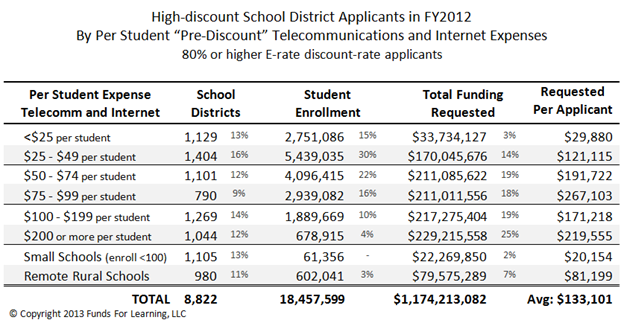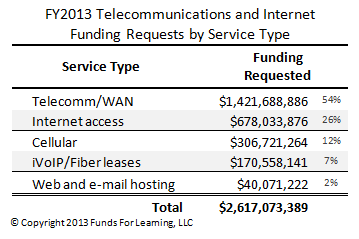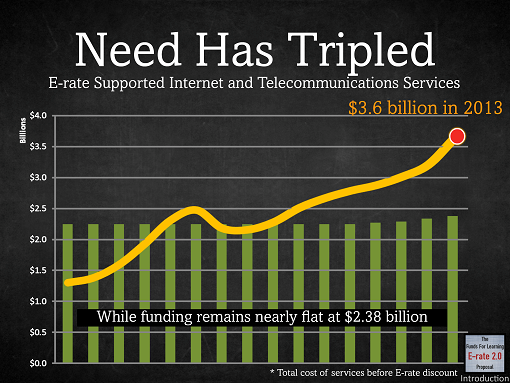It is difficult to debate potential solutions without first understanding the problem. Case in point: there is a lot of discussion right now about what changes should be made to the E-rate program. Those discussions stem from people’s view of what needs to be fixed. I find that the solutions bandied about are often rooted in perception, not fact. Today, I would like to debunk four misconceptions that I frequently encounter concerning the challenges facing the E‚Äërate program today.
Myth #1: Internal Connections Is Consuming the Fund
For the past two years, the demand for telecommunications and Internet access has exceeded the annual funding cap. The chart below illustrates the total demand for these so-called “Priority One” services.
School and library demand for telecommunications and Internet access has tripled since 1998. This should not come as a surprise to anyone. In 1998, I had a dial-up Internet connection at my house. I paid about $25 each month for the service. Today, I have a dedicated Internet connection for which I pay about $75/month. That is three times as much as I paid fifteen years ago. It’s no surprise that the demand in schools and libraries has tripled. The only real surprise may be that it has not increased more than it has.
Internal connections funding is considered a second priority by the FCC. Therefore, no internal connections funds are used before the demand for telecomm and Internet is satiated each year. It is incorrect to assume that internal connections are somehow depleting the E-rate fund. Proposed solutions that focus on reducing the scope of internal connections, or eliminating them entirely, will not address the deficiency of funds. In fact, there is anecdotal evidence to suggest that the lack of support for internal connections will further accelerate demand for telecomm and Internet as applicants look to more costly monthly services to connect their students to the Internet.
FACT: From the time that the FCC established the Priority funding system — with its all-or-nothing funding caps based on applicant discount rates — funding for internal connections projects has been drying up. Internal connections are one of the most cost-effective mechanisms for delivering bandwidth to students. That is why internal connections support was included in the original eligible services framework. Unfortunately, the false Priority 1 / Priority 2 dichotomy has forced schools to push more and more of their connectivity solutions into the telecommunications and Internet access categories.
Myth #2: High-Discount Schools Do Not Pay Enough
I frequently hear statements that high-discount schools do not have enough “skin in the game”. It is said that they underpay for their services and that they should be forced to pay more. No doubt, there are “Big Spenders” in the E-rate program: high-discount applicants who aggressively apply for funding to the tune of hundreds or even thousands of dollars per student. (In 2012, the average Big Spender requested 13.5 times as much per student for telecommunications and Internet access as the average applicant.
But there is a difference between being a high-discount school district and being a Big Spender. In 2012, there were 18.48 million students attending high discount rate school districts. 45% of these students were at school districts spending less than $50 per student. That’s about $4 per month (or less) per student for telecommunications and Internet access. That’s not unreasonable. And it certainly does not appear wasteful to me. See the table below.

Highlights from this table:
- The first two rows of this table represent 45% of high-discount students. You will note that this group submitted a total of $203,779,803 in telecommunications and Internet funding requests in FY2012. This is only about 17% of the entire telecomm and Internet funding requested by high-discount applicants.
- The last two rows of the table represent high discount rate, small enrollment and remote rural school districts. This group represents 3% of students nationwide, and requested 9% of all the high-discount telecommunications and Internet funding in 2012. NOTE: on average, the small schools requested $20,154 and the remote rural school districts requested $81,199. [These averages provide a basis for the “budget floors” in the Funds For Learning® E-rate 2.0 proposal.]
- The Big Spenders group ($200 or more per student) represents 4% of all students, but requested 25% of all high-discount telecomm and Internet requests.
Proponents of lowering E-rate discount rates fail to recognize the fact that a large portion of high discount applicants seek very reasonable amounts of funding. For example, in FY2012 there were 1,129 high discount rate applicants who requested less than $25 per student for telecommunications and Internet access. This group:
- Reports an average annual total telecommunications and Internet bill of $35,767. Of this amount, they requested, on average, E-rate support of $29,880, leaving them with a $5,888 annual out-of-pocket expense.
- Lowering the discount rate of this group by 20% is unlikely to reduce this group’s total annual telecommunications and Internet access expenditures. However, it will lower their E-rate funding requests. In 2012, a 20% discount reduction would lower their average request to $22,726, more than doubling their out-of-pocket expense, increasing it from $5,888 to $13,041. The net impact to the E-rate program for this dramatic increase: $8,076,295 in reduced demand.
FACT: The main argument for lowering discount rates appears to be a desire to reign in unreasonable expenditures. As this table shows, not all high discount applicants are Big Spenders. Many of these applicants submit requests below the national average. Lowering their discount rates would be punitive, and, as illustrated in Funds For Learning’s E-rate 2.0 Proposal, is not necessary in order to reign in funding requests and encourage cost-effective decision making.
Myth #3: The Funds For Learning Order Caused This
A favorite myth of mine is that the Funds For Learning Order, issued by the FCC on August 22, 2011, contributed to the current challenges facing the E-rate program. The argument goes like this: if Funds For Learning® had not petitioned the FCC to fund applicants back in 2010, there would still be money for internal connections in 2013.
Here is the background you need to know about the Funds For Learning Order:
- On February 11, 2011, Funds For Learning® petitioned the FCC on behalf of all E-rate applicants, requesting that the FCC allow funding for FY2010 internal connections requests below the 82% discount rate level.
- On August 22, 2011, the FCC released the Funds For Learning Order allowing USAC to fund all internal connections funding requests in FY2010.
To date, the Funds For Learning Order has resulted in an additional $276,704,500 in FY2010 internal connections funding commitments:
- 1,638 applicants received internal connections funding at or below the 81% discount rate.
- The largest benefactor was New York City schools, receiving an additional $34,361,068 in funding commitments.
- There is still pending $14,640,578 in FY2010 internal connections requests, primarily for NYC schools ($10.1 million) and Dallas ISD ($3.7 million), with another $0.9 million spread among 5 other schools.
- Of the funds committed, $133,007,690 has been disbursed, with a remaining amount of $143,696,860 still waiting to be spent. (The unspent funds are likely due to the long delay in receiving a funding commitment. As described in this analysis, there is a clear linkage between the issuance date of a funding decision, and its utilization.)
FACT: The total impact of the Funds For Learning Order will be no more than $276.7 million. To date, it has resulted in the disbursement of $133 million in funds. Realistically, by the time all projects are completed and funding utilized, it is unlikely that the Order will result in more than $200 million in disbursements. Had all of that money been saved for 90%-discount schools, it would still only cover at most 10% to 15% of the FY2013 demand for internal connections at the 90%-discount rate.
Myth #4: Web Hosting and iVoIP Caused This
One of the most common, if not THE most common, recommendations that I hear is the elimination of iVoIP and web-hosting services from the eligible services list — as if connecting students with new technologies is somehow contrary to the E-rate program’s mandate! Here is the breakdown of telecomm and Internet demand in FY2013:

FACT: Set aside for a moment the policy discussion of whether or not web-hosting, iVoIP or other non-traditional means of connecting students serves the purpose of the program, is cost-effective, etc. The basic math is pretty clear. If you eliminate these services entirely, the FY2013 demand for the other services would still exceed the funding cap.
The Funds For Learning® Proposal
Funds For Learning® has prepared a proposal to address the real issues facing the E-rate program today. This proposal keeps the current discount matrix, eligible services list, and application process. Based on a 2003 Waste, Fraud and Abuse Task Force recommendation, the proposal is designed to:
- Ensure that all schools and libraries have the opportunity to receive E-rate discounts
- Reestablish funding for wireless access points and other related internal connections
- Reinstate a sliding scale of discount support, with the highest discounts reserved for the neediest applicants
- End the current “all or nothing” discount threshold funding cap system
- Restore the technology-neutral design of the E-rate by eliminating the Priority System
- Give schools additional incentive to submit accurate funding requests and select the most cost-effective solutions.
- Guard against big spenders who request a disproportionate amount of the fund
- Allow for faster funding commitment decisions, more flexible use of funds, and more local decision making
You can read more about the Funds For Learning® E-rate 2.0 proposal at this site.

